Entrepreneurship & Business: Growth, Planning & Development Ideas
VerifiedAdded on 2024/06/04
|18
|4072
|58
Report
AI Summary
This assignment provides a comprehensive overview of entrepreneurship and its application in a stable business environment. It delves into the scope of entrepreneurship, factors limiting its growth, and its contribution to economic development, with a focus on the UK market. The report evaluates methods for developing successful business ideas, emphasizes the importance of feasibility analysis, and critically assesses various idea generation techniques. Furthermore, it outlines strategies for viable entrepreneurship, including idea, operation management, marketing, and finance strategies. A market research plan for a retail business in the UK is also discussed, highlighting key aspects of planning and development. Desklib offers a variety of study tools, including past papers and solved assignments, to aid students in their academic pursuits.

Entrepreneurship & Business
Paraphrase This Document
Need a fresh take? Get an instant paraphrase of this document with our AI Paraphraser

Contents
INTRODUCTION...........................................................................................................................................2
PART 1.........................................................................................................................................................3
1.1............................................................................................................................................................3
1.2............................................................................................................................................................4
1.3............................................................................................................................................................5
PART 2.........................................................................................................................................................6
2.1............................................................................................................................................................6
2.2............................................................................................................................................................7
2.3............................................................................................................................................................8
PART 3.........................................................................................................................................................9
3.1............................................................................................................................................................9
3.2 & 3.2................................................................................................................................................10
PART 4.......................................................................................................................................................13
4.1..........................................................................................................................................................13
4.2..........................................................................................................................................................14
4.3..........................................................................................................................................................15
CONCLUSION.............................................................................................................................................16
REFERENCES..............................................................................................................................................17
1
INTRODUCTION...........................................................................................................................................2
PART 1.........................................................................................................................................................3
1.1............................................................................................................................................................3
1.2............................................................................................................................................................4
1.3............................................................................................................................................................5
PART 2.........................................................................................................................................................6
2.1............................................................................................................................................................6
2.2............................................................................................................................................................7
2.3............................................................................................................................................................8
PART 3.........................................................................................................................................................9
3.1............................................................................................................................................................9
3.2 & 3.2................................................................................................................................................10
PART 4.......................................................................................................................................................13
4.1..........................................................................................................................................................13
4.2..........................................................................................................................................................14
4.3..........................................................................................................................................................15
CONCLUSION.............................................................................................................................................16
REFERENCES..............................................................................................................................................17
1
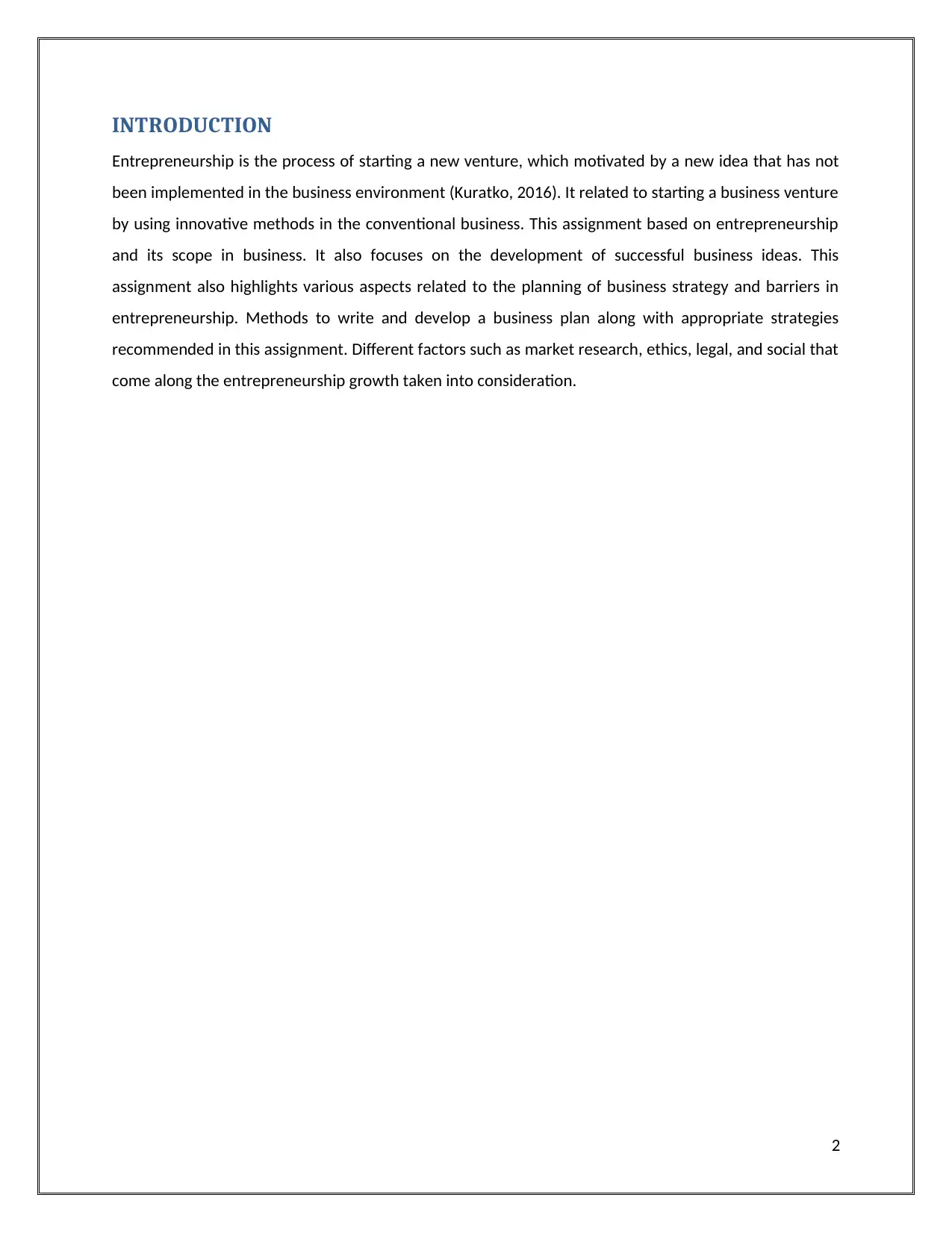
INTRODUCTION
Entrepreneurship is the process of starting a new venture, which motivated by a new idea that has not
been implemented in the business environment (Kuratko, 2016). It related to starting a business venture
by using innovative methods in the conventional business. This assignment based on entrepreneurship
and its scope in business. It also focuses on the development of successful business ideas. This
assignment also highlights various aspects related to the planning of business strategy and barriers in
entrepreneurship. Methods to write and develop a business plan along with appropriate strategies
recommended in this assignment. Different factors such as market research, ethics, legal, and social that
come along the entrepreneurship growth taken into consideration.
2
Entrepreneurship is the process of starting a new venture, which motivated by a new idea that has not
been implemented in the business environment (Kuratko, 2016). It related to starting a business venture
by using innovative methods in the conventional business. This assignment based on entrepreneurship
and its scope in business. It also focuses on the development of successful business ideas. This
assignment also highlights various aspects related to the planning of business strategy and barriers in
entrepreneurship. Methods to write and develop a business plan along with appropriate strategies
recommended in this assignment. Different factors such as market research, ethics, legal, and social that
come along the entrepreneurship growth taken into consideration.
2
You're viewing a preview
Unlock full access by subscribing today!
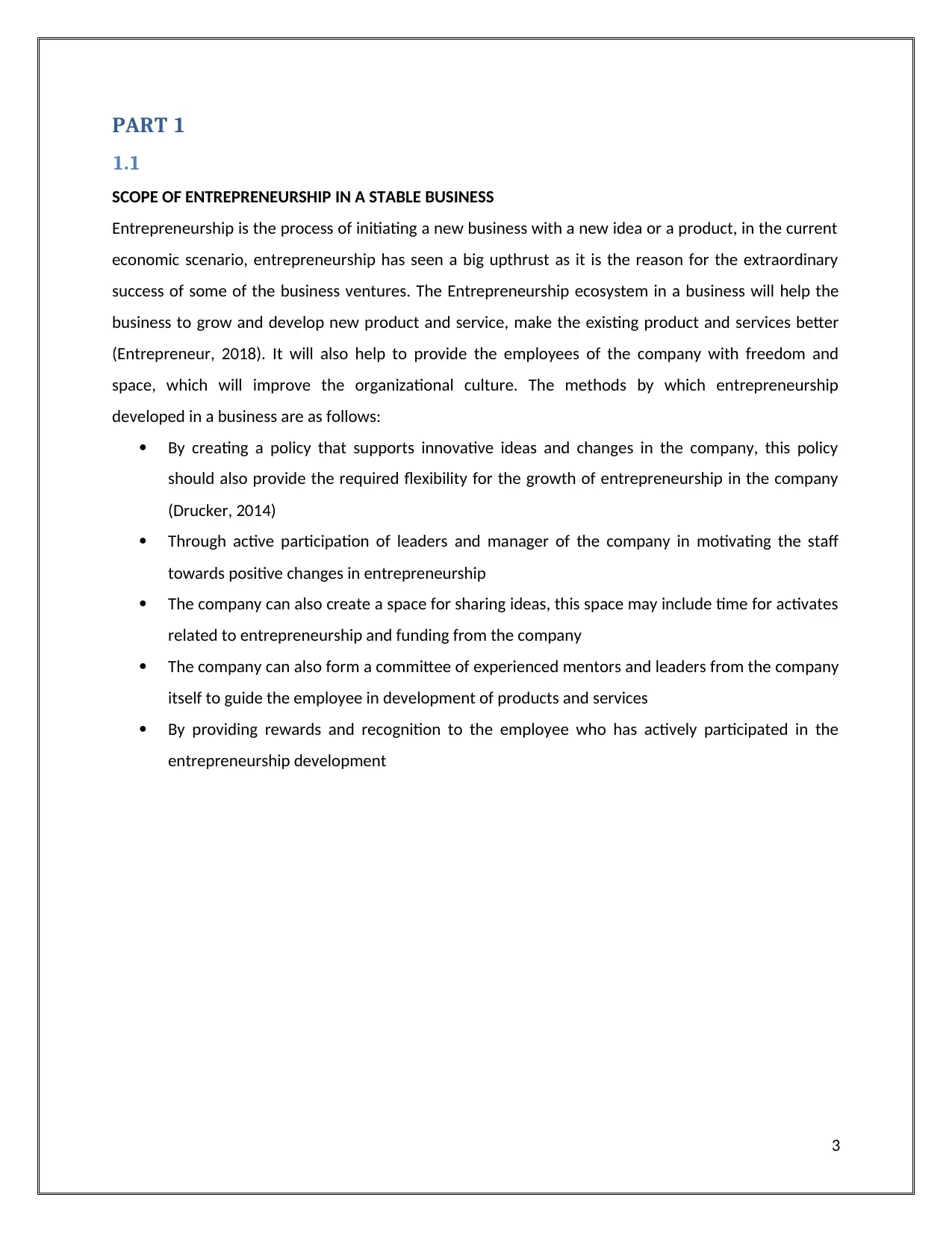
PART 1
1.1
SCOPE OF ENTREPRENEURSHIP IN A STABLE BUSINESS
Entrepreneurship is the process of initiating a new business with a new idea or a product, in the current
economic scenario, entrepreneurship has seen a big upthrust as it is the reason for the extraordinary
success of some of the business ventures. The Entrepreneurship ecosystem in a business will help the
business to grow and develop new product and service, make the existing product and services better
(Entrepreneur, 2018). It will also help to provide the employees of the company with freedom and
space, which will improve the organizational culture. The methods by which entrepreneurship
developed in a business are as follows:
By creating a policy that supports innovative ideas and changes in the company, this policy
should also provide the required flexibility for the growth of entrepreneurship in the company
(Drucker, 2014)
Through active participation of leaders and manager of the company in motivating the staff
towards positive changes in entrepreneurship
The company can also create a space for sharing ideas, this space may include time for activates
related to entrepreneurship and funding from the company
The company can also form a committee of experienced mentors and leaders from the company
itself to guide the employee in development of products and services
By providing rewards and recognition to the employee who has actively participated in the
entrepreneurship development
3
1.1
SCOPE OF ENTREPRENEURSHIP IN A STABLE BUSINESS
Entrepreneurship is the process of initiating a new business with a new idea or a product, in the current
economic scenario, entrepreneurship has seen a big upthrust as it is the reason for the extraordinary
success of some of the business ventures. The Entrepreneurship ecosystem in a business will help the
business to grow and develop new product and service, make the existing product and services better
(Entrepreneur, 2018). It will also help to provide the employees of the company with freedom and
space, which will improve the organizational culture. The methods by which entrepreneurship
developed in a business are as follows:
By creating a policy that supports innovative ideas and changes in the company, this policy
should also provide the required flexibility for the growth of entrepreneurship in the company
(Drucker, 2014)
Through active participation of leaders and manager of the company in motivating the staff
towards positive changes in entrepreneurship
The company can also create a space for sharing ideas, this space may include time for activates
related to entrepreneurship and funding from the company
The company can also form a committee of experienced mentors and leaders from the company
itself to guide the employee in development of products and services
By providing rewards and recognition to the employee who has actively participated in the
entrepreneurship development
3
Paraphrase This Document
Need a fresh take? Get an instant paraphrase of this document with our AI Paraphraser
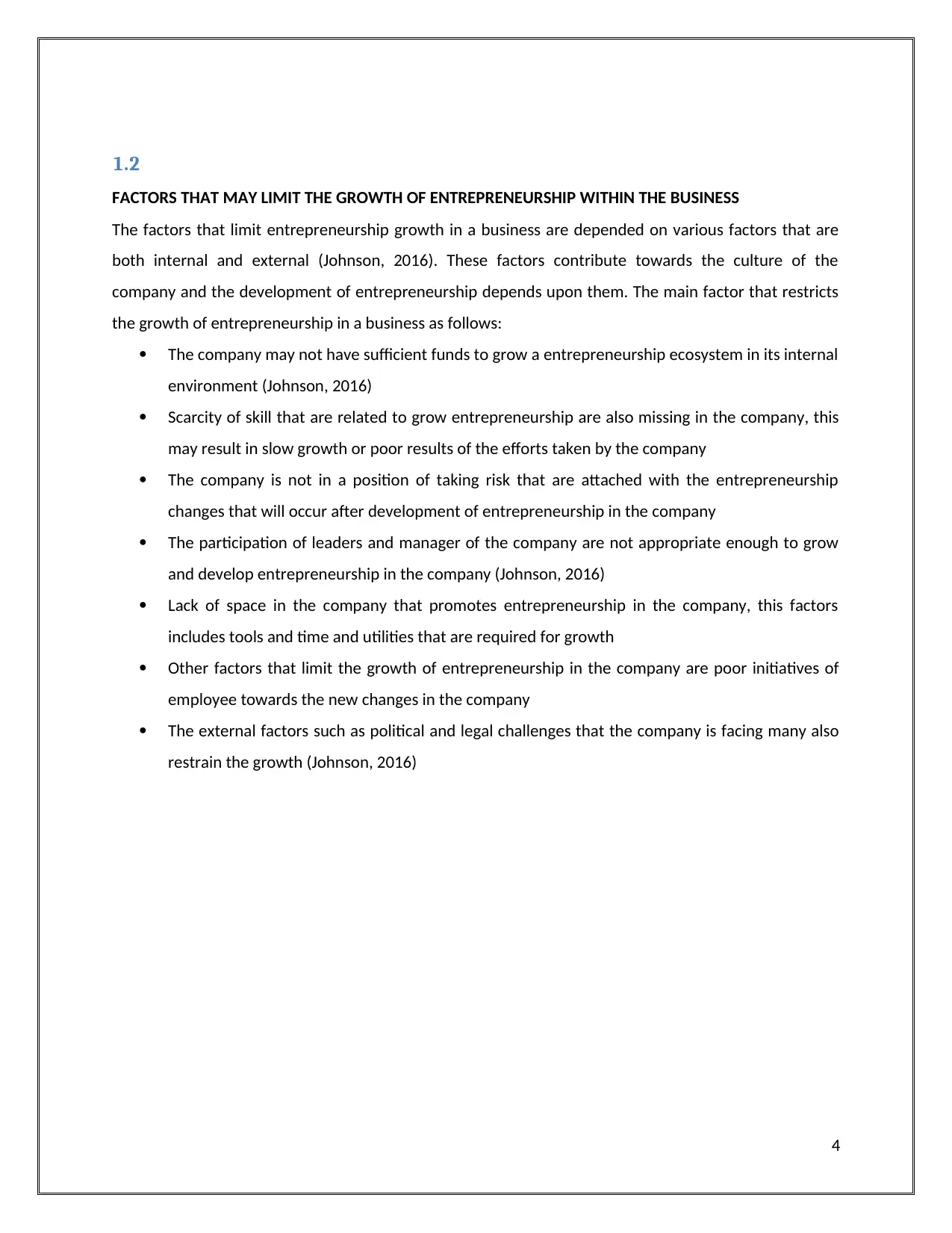
1.2
FACTORS THAT MAY LIMIT THE GROWTH OF ENTREPRENEURSHIP WITHIN THE BUSINESS
The factors that limit entrepreneurship growth in a business are depended on various factors that are
both internal and external (Johnson, 2016). These factors contribute towards the culture of the
company and the development of entrepreneurship depends upon them. The main factor that restricts
the growth of entrepreneurship in a business as follows:
The company may not have sufficient funds to grow a entrepreneurship ecosystem in its internal
environment (Johnson, 2016)
Scarcity of skill that are related to grow entrepreneurship are also missing in the company, this
may result in slow growth or poor results of the efforts taken by the company
The company is not in a position of taking risk that are attached with the entrepreneurship
changes that will occur after development of entrepreneurship in the company
The participation of leaders and manager of the company are not appropriate enough to grow
and develop entrepreneurship in the company (Johnson, 2016)
Lack of space in the company that promotes entrepreneurship in the company, this factors
includes tools and time and utilities that are required for growth
Other factors that limit the growth of entrepreneurship in the company are poor initiatives of
employee towards the new changes in the company
The external factors such as political and legal challenges that the company is facing many also
restrain the growth (Johnson, 2016)
4
FACTORS THAT MAY LIMIT THE GROWTH OF ENTREPRENEURSHIP WITHIN THE BUSINESS
The factors that limit entrepreneurship growth in a business are depended on various factors that are
both internal and external (Johnson, 2016). These factors contribute towards the culture of the
company and the development of entrepreneurship depends upon them. The main factor that restricts
the growth of entrepreneurship in a business as follows:
The company may not have sufficient funds to grow a entrepreneurship ecosystem in its internal
environment (Johnson, 2016)
Scarcity of skill that are related to grow entrepreneurship are also missing in the company, this
may result in slow growth or poor results of the efforts taken by the company
The company is not in a position of taking risk that are attached with the entrepreneurship
changes that will occur after development of entrepreneurship in the company
The participation of leaders and manager of the company are not appropriate enough to grow
and develop entrepreneurship in the company (Johnson, 2016)
Lack of space in the company that promotes entrepreneurship in the company, this factors
includes tools and time and utilities that are required for growth
Other factors that limit the growth of entrepreneurship in the company are poor initiatives of
employee towards the new changes in the company
The external factors such as political and legal challenges that the company is facing many also
restrain the growth (Johnson, 2016)
4
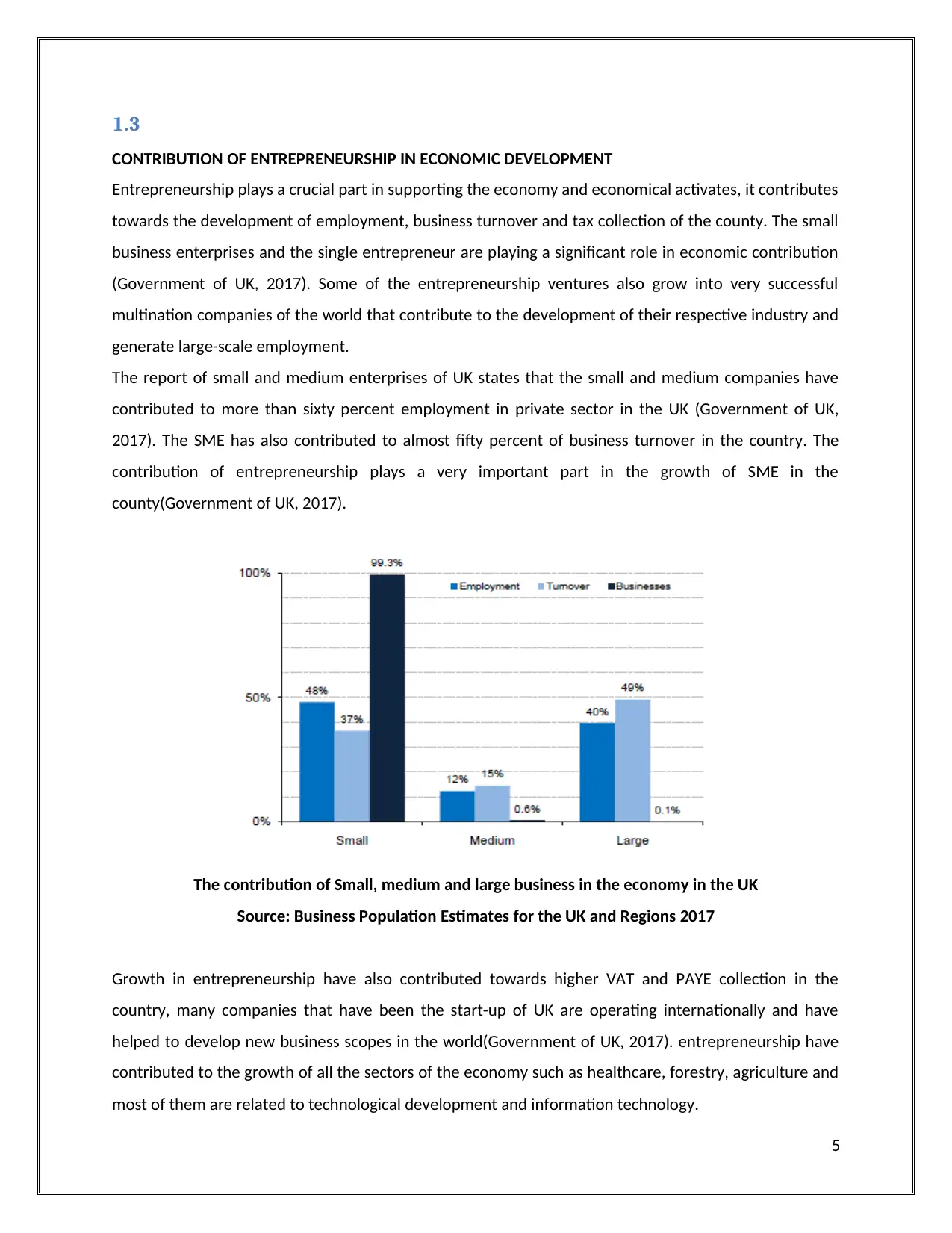
1.3
CONTRIBUTION OF ENTREPRENEURSHIP IN ECONOMIC DEVELOPMENT
Entrepreneurship plays a crucial part in supporting the economy and economical activates, it contributes
towards the development of employment, business turnover and tax collection of the county. The small
business enterprises and the single entrepreneur are playing a significant role in economic contribution
(Government of UK, 2017). Some of the entrepreneurship ventures also grow into very successful
multination companies of the world that contribute to the development of their respective industry and
generate large-scale employment.
The report of small and medium enterprises of UK states that the small and medium companies have
contributed to more than sixty percent employment in private sector in the UK (Government of UK,
2017). The SME has also contributed to almost fifty percent of business turnover in the country. The
contribution of entrepreneurship plays a very important part in the growth of SME in the
county(Government of UK, 2017).
The contribution of Small, medium and large business in the economy in the UK
Source: Business Population Estimates for the UK and Regions 2017
Growth in entrepreneurship have also contributed towards higher VAT and PAYE collection in the
country, many companies that have been the start-up of UK are operating internationally and have
helped to develop new business scopes in the world(Government of UK, 2017). entrepreneurship have
contributed to the growth of all the sectors of the economy such as healthcare, forestry, agriculture and
most of them are related to technological development and information technology.
5
CONTRIBUTION OF ENTREPRENEURSHIP IN ECONOMIC DEVELOPMENT
Entrepreneurship plays a crucial part in supporting the economy and economical activates, it contributes
towards the development of employment, business turnover and tax collection of the county. The small
business enterprises and the single entrepreneur are playing a significant role in economic contribution
(Government of UK, 2017). Some of the entrepreneurship ventures also grow into very successful
multination companies of the world that contribute to the development of their respective industry and
generate large-scale employment.
The report of small and medium enterprises of UK states that the small and medium companies have
contributed to more than sixty percent employment in private sector in the UK (Government of UK,
2017). The SME has also contributed to almost fifty percent of business turnover in the country. The
contribution of entrepreneurship plays a very important part in the growth of SME in the
county(Government of UK, 2017).
The contribution of Small, medium and large business in the economy in the UK
Source: Business Population Estimates for the UK and Regions 2017
Growth in entrepreneurship have also contributed towards higher VAT and PAYE collection in the
country, many companies that have been the start-up of UK are operating internationally and have
helped to develop new business scopes in the world(Government of UK, 2017). entrepreneurship have
contributed to the growth of all the sectors of the economy such as healthcare, forestry, agriculture and
most of them are related to technological development and information technology.
5
You're viewing a preview
Unlock full access by subscribing today!
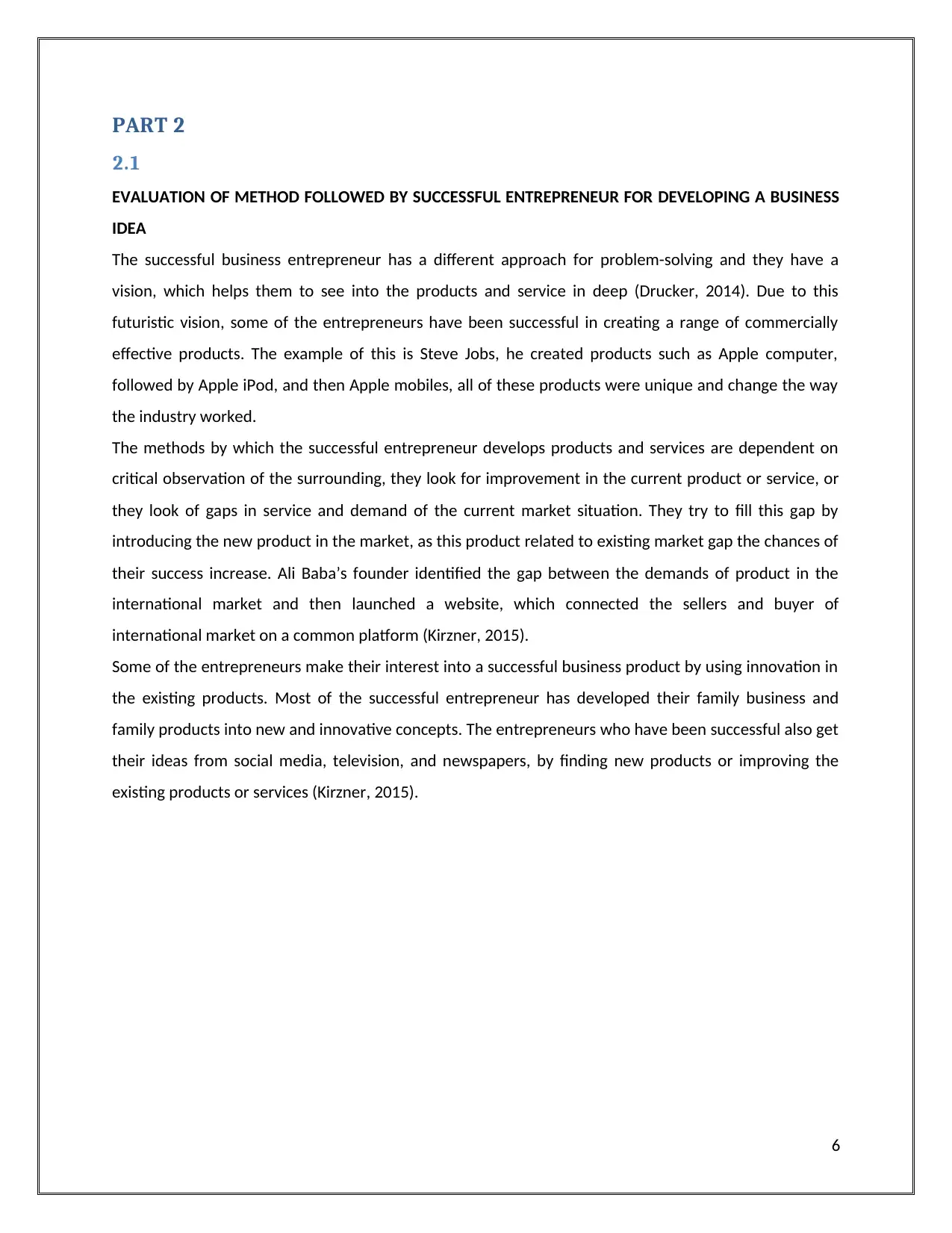
PART 2
2.1
EVALUATION OF METHOD FOLLOWED BY SUCCESSFUL ENTREPRENEUR FOR DEVELOPING A BUSINESS
IDEA
The successful business entrepreneur has a different approach for problem-solving and they have a
vision, which helps them to see into the products and service in deep (Drucker, 2014). Due to this
futuristic vision, some of the entrepreneurs have been successful in creating a range of commercially
effective products. The example of this is Steve Jobs, he created products such as Apple computer,
followed by Apple iPod, and then Apple mobiles, all of these products were unique and change the way
the industry worked.
The methods by which the successful entrepreneur develops products and services are dependent on
critical observation of the surrounding, they look for improvement in the current product or service, or
they look of gaps in service and demand of the current market situation. They try to fill this gap by
introducing the new product in the market, as this product related to existing market gap the chances of
their success increase. Ali Baba’s founder identified the gap between the demands of product in the
international market and then launched a website, which connected the sellers and buyer of
international market on a common platform (Kirzner, 2015).
Some of the entrepreneurs make their interest into a successful business product by using innovation in
the existing products. Most of the successful entrepreneur has developed their family business and
family products into new and innovative concepts. The entrepreneurs who have been successful also get
their ideas from social media, television, and newspapers, by finding new products or improving the
existing products or services (Kirzner, 2015).
6
2.1
EVALUATION OF METHOD FOLLOWED BY SUCCESSFUL ENTREPRENEUR FOR DEVELOPING A BUSINESS
IDEA
The successful business entrepreneur has a different approach for problem-solving and they have a
vision, which helps them to see into the products and service in deep (Drucker, 2014). Due to this
futuristic vision, some of the entrepreneurs have been successful in creating a range of commercially
effective products. The example of this is Steve Jobs, he created products such as Apple computer,
followed by Apple iPod, and then Apple mobiles, all of these products were unique and change the way
the industry worked.
The methods by which the successful entrepreneur develops products and services are dependent on
critical observation of the surrounding, they look for improvement in the current product or service, or
they look of gaps in service and demand of the current market situation. They try to fill this gap by
introducing the new product in the market, as this product related to existing market gap the chances of
their success increase. Ali Baba’s founder identified the gap between the demands of product in the
international market and then launched a website, which connected the sellers and buyer of
international market on a common platform (Kirzner, 2015).
Some of the entrepreneurs make their interest into a successful business product by using innovation in
the existing products. Most of the successful entrepreneur has developed their family business and
family products into new and innovative concepts. The entrepreneurs who have been successful also get
their ideas from social media, television, and newspapers, by finding new products or improving the
existing products or services (Kirzner, 2015).
6
Paraphrase This Document
Need a fresh take? Get an instant paraphrase of this document with our AI Paraphraser
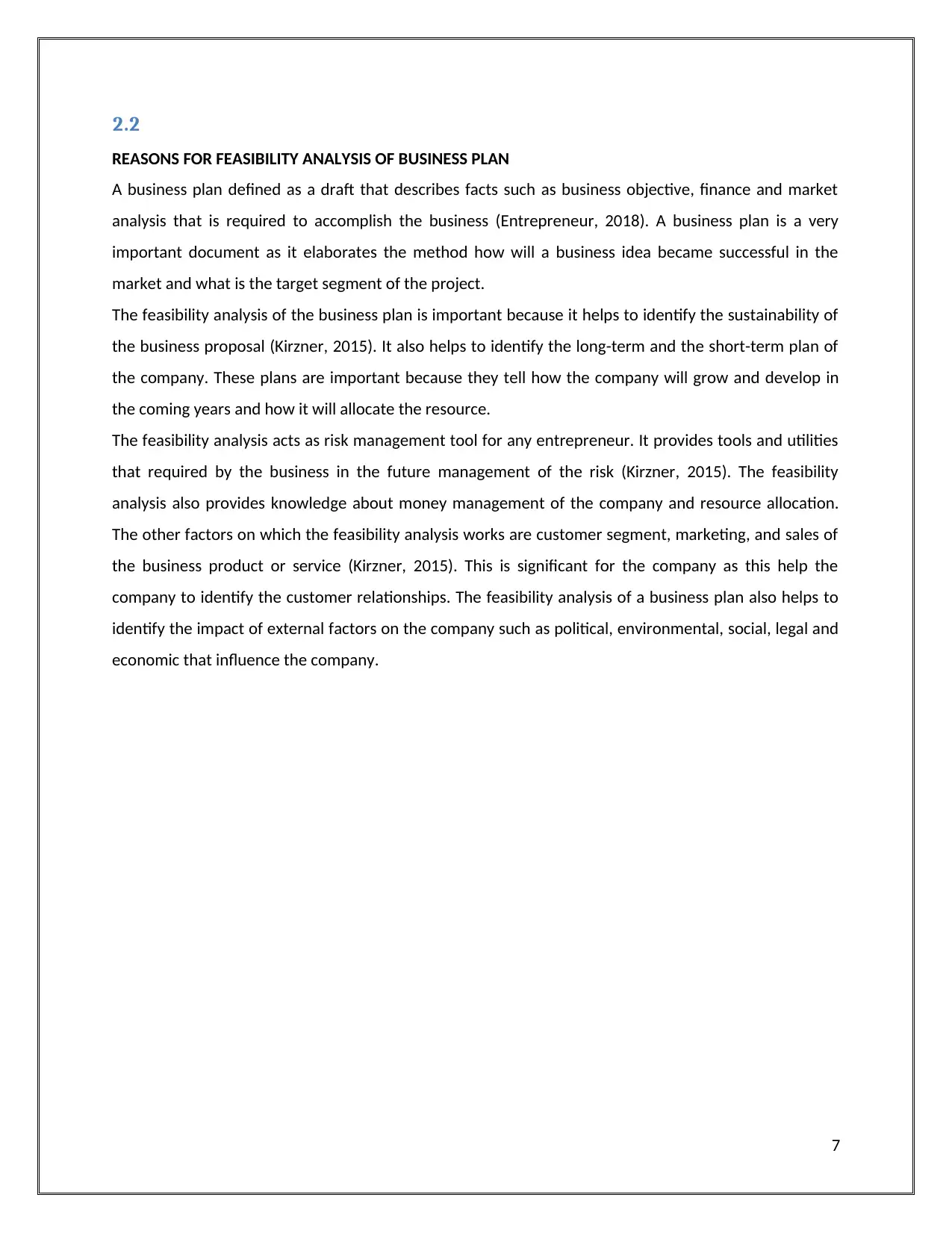
2.2
REASONS FOR FEASIBILITY ANALYSIS OF BUSINESS PLAN
A business plan defined as a draft that describes facts such as business objective, finance and market
analysis that is required to accomplish the business (Entrepreneur, 2018). A business plan is a very
important document as it elaborates the method how will a business idea became successful in the
market and what is the target segment of the project.
The feasibility analysis of the business plan is important because it helps to identify the sustainability of
the business proposal (Kirzner, 2015). It also helps to identify the long-term and the short-term plan of
the company. These plans are important because they tell how the company will grow and develop in
the coming years and how it will allocate the resource.
The feasibility analysis acts as risk management tool for any entrepreneur. It provides tools and utilities
that required by the business in the future management of the risk (Kirzner, 2015). The feasibility
analysis also provides knowledge about money management of the company and resource allocation.
The other factors on which the feasibility analysis works are customer segment, marketing, and sales of
the business product or service (Kirzner, 2015). This is significant for the company as this help the
company to identify the customer relationships. The feasibility analysis of a business plan also helps to
identify the impact of external factors on the company such as political, environmental, social, legal and
economic that influence the company.
7
REASONS FOR FEASIBILITY ANALYSIS OF BUSINESS PLAN
A business plan defined as a draft that describes facts such as business objective, finance and market
analysis that is required to accomplish the business (Entrepreneur, 2018). A business plan is a very
important document as it elaborates the method how will a business idea became successful in the
market and what is the target segment of the project.
The feasibility analysis of the business plan is important because it helps to identify the sustainability of
the business proposal (Kirzner, 2015). It also helps to identify the long-term and the short-term plan of
the company. These plans are important because they tell how the company will grow and develop in
the coming years and how it will allocate the resource.
The feasibility analysis acts as risk management tool for any entrepreneur. It provides tools and utilities
that required by the business in the future management of the risk (Kirzner, 2015). The feasibility
analysis also provides knowledge about money management of the company and resource allocation.
The other factors on which the feasibility analysis works are customer segment, marketing, and sales of
the business product or service (Kirzner, 2015). This is significant for the company as this help the
company to identify the customer relationships. The feasibility analysis of a business plan also helps to
identify the impact of external factors on the company such as political, environmental, social, legal and
economic that influence the company.
7
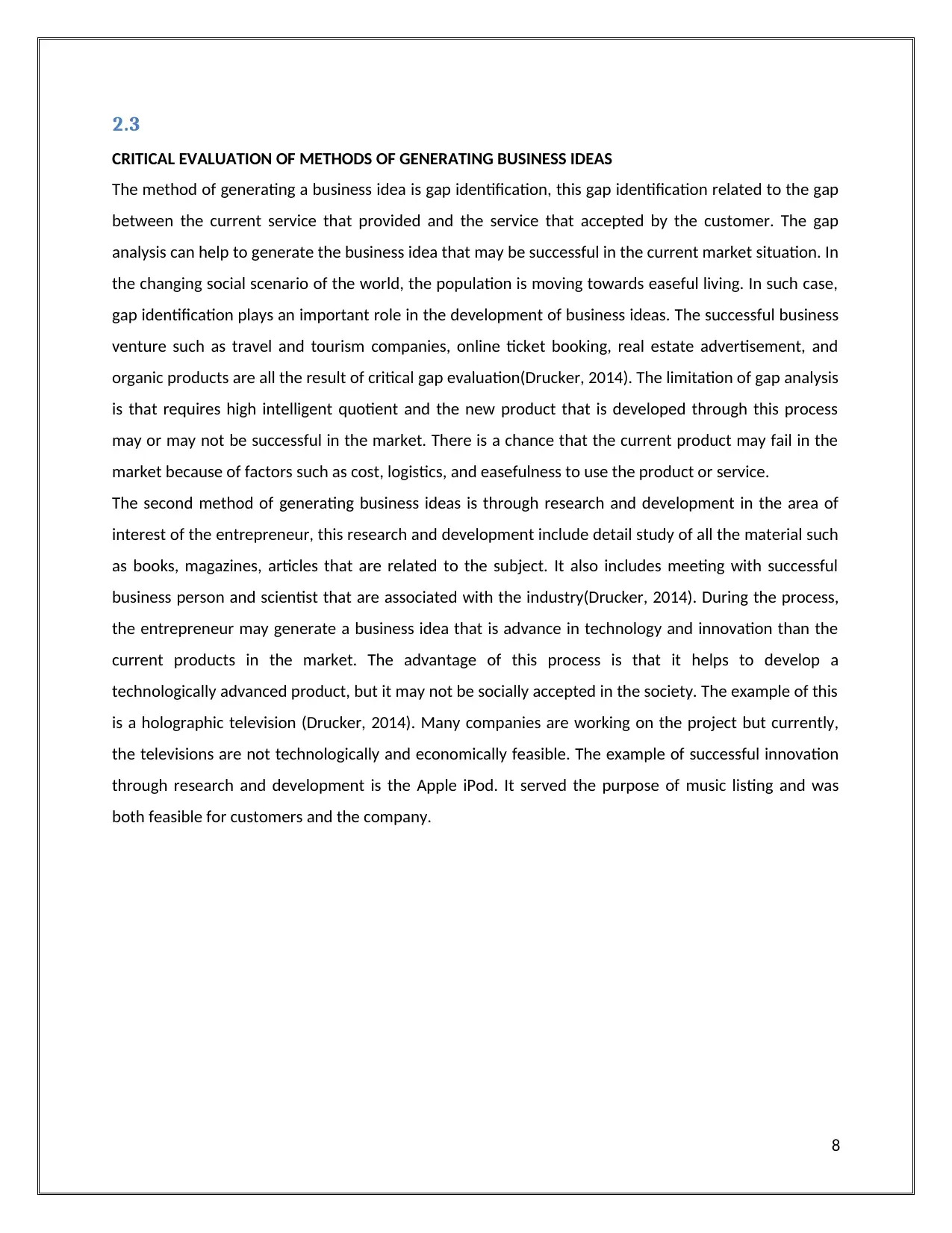
2.3
CRITICAL EVALUATION OF METHODS OF GENERATING BUSINESS IDEAS
The method of generating a business idea is gap identification, this gap identification related to the gap
between the current service that provided and the service that accepted by the customer. The gap
analysis can help to generate the business idea that may be successful in the current market situation. In
the changing social scenario of the world, the population is moving towards easeful living. In such case,
gap identification plays an important role in the development of business ideas. The successful business
venture such as travel and tourism companies, online ticket booking, real estate advertisement, and
organic products are all the result of critical gap evaluation(Drucker, 2014). The limitation of gap analysis
is that requires high intelligent quotient and the new product that is developed through this process
may or may not be successful in the market. There is a chance that the current product may fail in the
market because of factors such as cost, logistics, and easefulness to use the product or service.
The second method of generating business ideas is through research and development in the area of
interest of the entrepreneur, this research and development include detail study of all the material such
as books, magazines, articles that are related to the subject. It also includes meeting with successful
business person and scientist that are associated with the industry(Drucker, 2014). During the process,
the entrepreneur may generate a business idea that is advance in technology and innovation than the
current products in the market. The advantage of this process is that it helps to develop a
technologically advanced product, but it may not be socially accepted in the society. The example of this
is a holographic television (Drucker, 2014). Many companies are working on the project but currently,
the televisions are not technologically and economically feasible. The example of successful innovation
through research and development is the Apple iPod. It served the purpose of music listing and was
both feasible for customers and the company.
8
CRITICAL EVALUATION OF METHODS OF GENERATING BUSINESS IDEAS
The method of generating a business idea is gap identification, this gap identification related to the gap
between the current service that provided and the service that accepted by the customer. The gap
analysis can help to generate the business idea that may be successful in the current market situation. In
the changing social scenario of the world, the population is moving towards easeful living. In such case,
gap identification plays an important role in the development of business ideas. The successful business
venture such as travel and tourism companies, online ticket booking, real estate advertisement, and
organic products are all the result of critical gap evaluation(Drucker, 2014). The limitation of gap analysis
is that requires high intelligent quotient and the new product that is developed through this process
may or may not be successful in the market. There is a chance that the current product may fail in the
market because of factors such as cost, logistics, and easefulness to use the product or service.
The second method of generating business ideas is through research and development in the area of
interest of the entrepreneur, this research and development include detail study of all the material such
as books, magazines, articles that are related to the subject. It also includes meeting with successful
business person and scientist that are associated with the industry(Drucker, 2014). During the process,
the entrepreneur may generate a business idea that is advance in technology and innovation than the
current products in the market. The advantage of this process is that it helps to develop a
technologically advanced product, but it may not be socially accepted in the society. The example of this
is a holographic television (Drucker, 2014). Many companies are working on the project but currently,
the televisions are not technologically and economically feasible. The example of successful innovation
through research and development is the Apple iPod. It served the purpose of music listing and was
both feasible for customers and the company.
8
You're viewing a preview
Unlock full access by subscribing today!
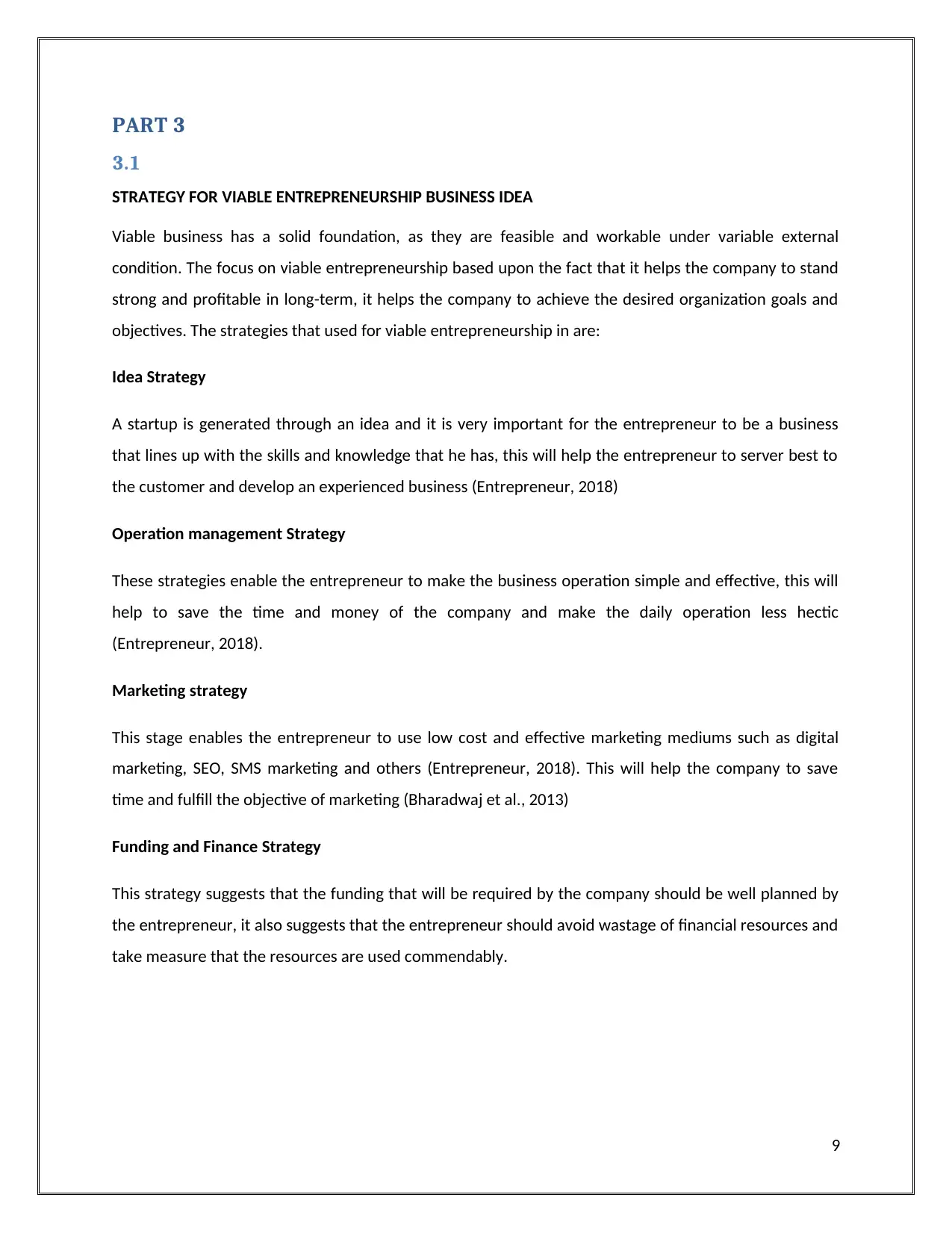
PART 3
3.1
STRATEGY FOR VIABLE ENTREPRENEURSHIP BUSINESS IDEA
Viable business has a solid foundation, as they are feasible and workable under variable external
condition. The focus on viable entrepreneurship based upon the fact that it helps the company to stand
strong and profitable in long-term, it helps the company to achieve the desired organization goals and
objectives. The strategies that used for viable entrepreneurship in are:
Idea Strategy
A startup is generated through an idea and it is very important for the entrepreneur to be a business
that lines up with the skills and knowledge that he has, this will help the entrepreneur to server best to
the customer and develop an experienced business (Entrepreneur, 2018)
Operation management Strategy
These strategies enable the entrepreneur to make the business operation simple and effective, this will
help to save the time and money of the company and make the daily operation less hectic
(Entrepreneur, 2018).
Marketing strategy
This stage enables the entrepreneur to use low cost and effective marketing mediums such as digital
marketing, SEO, SMS marketing and others (Entrepreneur, 2018). This will help the company to save
time and fulfill the objective of marketing (Bharadwaj et al., 2013)
Funding and Finance Strategy
This strategy suggests that the funding that will be required by the company should be well planned by
the entrepreneur, it also suggests that the entrepreneur should avoid wastage of financial resources and
take measure that the resources are used commendably.
9
3.1
STRATEGY FOR VIABLE ENTREPRENEURSHIP BUSINESS IDEA
Viable business has a solid foundation, as they are feasible and workable under variable external
condition. The focus on viable entrepreneurship based upon the fact that it helps the company to stand
strong and profitable in long-term, it helps the company to achieve the desired organization goals and
objectives. The strategies that used for viable entrepreneurship in are:
Idea Strategy
A startup is generated through an idea and it is very important for the entrepreneur to be a business
that lines up with the skills and knowledge that he has, this will help the entrepreneur to server best to
the customer and develop an experienced business (Entrepreneur, 2018)
Operation management Strategy
These strategies enable the entrepreneur to make the business operation simple and effective, this will
help to save the time and money of the company and make the daily operation less hectic
(Entrepreneur, 2018).
Marketing strategy
This stage enables the entrepreneur to use low cost and effective marketing mediums such as digital
marketing, SEO, SMS marketing and others (Entrepreneur, 2018). This will help the company to save
time and fulfill the objective of marketing (Bharadwaj et al., 2013)
Funding and Finance Strategy
This strategy suggests that the funding that will be required by the company should be well planned by
the entrepreneur, it also suggests that the entrepreneur should avoid wastage of financial resources and
take measure that the resources are used commendably.
9
Paraphrase This Document
Need a fresh take? Get an instant paraphrase of this document with our AI Paraphraser
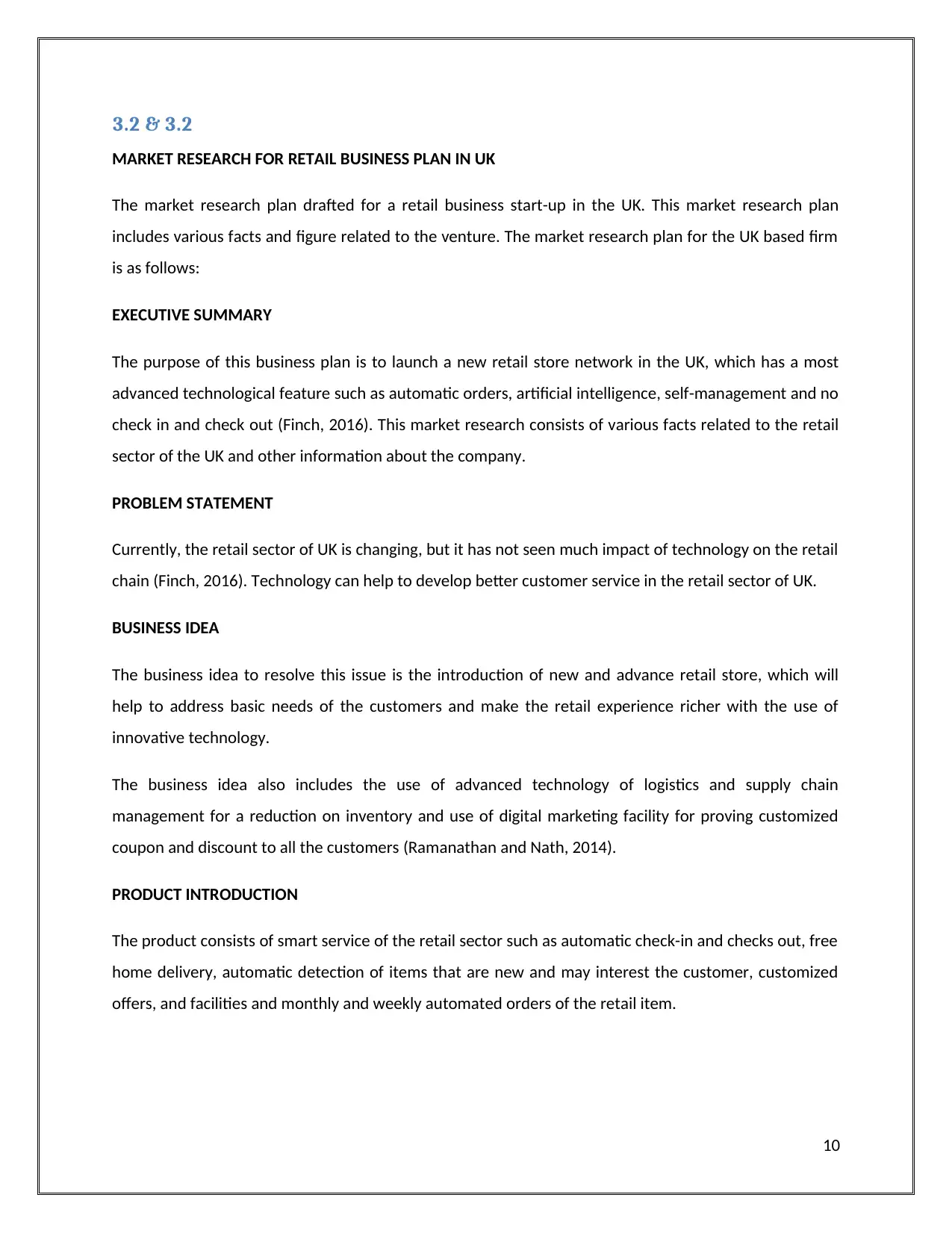
3.2 & 3.2
MARKET RESEARCH FOR RETAIL BUSINESS PLAN IN UK
The market research plan drafted for a retail business start-up in the UK. This market research plan
includes various facts and figure related to the venture. The market research plan for the UK based firm
is as follows:
EXECUTIVE SUMMARY
The purpose of this business plan is to launch a new retail store network in the UK, which has a most
advanced technological feature such as automatic orders, artificial intelligence, self-management and no
check in and check out (Finch, 2016). This market research consists of various facts related to the retail
sector of the UK and other information about the company.
PROBLEM STATEMENT
Currently, the retail sector of UK is changing, but it has not seen much impact of technology on the retail
chain (Finch, 2016). Technology can help to develop better customer service in the retail sector of UK.
BUSINESS IDEA
The business idea to resolve this issue is the introduction of new and advance retail store, which will
help to address basic needs of the customers and make the retail experience richer with the use of
innovative technology.
The business idea also includes the use of advanced technology of logistics and supply chain
management for a reduction on inventory and use of digital marketing facility for proving customized
coupon and discount to all the customers (Ramanathan and Nath, 2014).
PRODUCT INTRODUCTION
The product consists of smart service of the retail sector such as automatic check-in and checks out, free
home delivery, automatic detection of items that are new and may interest the customer, customized
offers, and facilities and monthly and weekly automated orders of the retail item.
10
MARKET RESEARCH FOR RETAIL BUSINESS PLAN IN UK
The market research plan drafted for a retail business start-up in the UK. This market research plan
includes various facts and figure related to the venture. The market research plan for the UK based firm
is as follows:
EXECUTIVE SUMMARY
The purpose of this business plan is to launch a new retail store network in the UK, which has a most
advanced technological feature such as automatic orders, artificial intelligence, self-management and no
check in and check out (Finch, 2016). This market research consists of various facts related to the retail
sector of the UK and other information about the company.
PROBLEM STATEMENT
Currently, the retail sector of UK is changing, but it has not seen much impact of technology on the retail
chain (Finch, 2016). Technology can help to develop better customer service in the retail sector of UK.
BUSINESS IDEA
The business idea to resolve this issue is the introduction of new and advance retail store, which will
help to address basic needs of the customers and make the retail experience richer with the use of
innovative technology.
The business idea also includes the use of advanced technology of logistics and supply chain
management for a reduction on inventory and use of digital marketing facility for proving customized
coupon and discount to all the customers (Ramanathan and Nath, 2014).
PRODUCT INTRODUCTION
The product consists of smart service of the retail sector such as automatic check-in and checks out, free
home delivery, automatic detection of items that are new and may interest the customer, customized
offers, and facilities and monthly and weekly automated orders of the retail item.
10
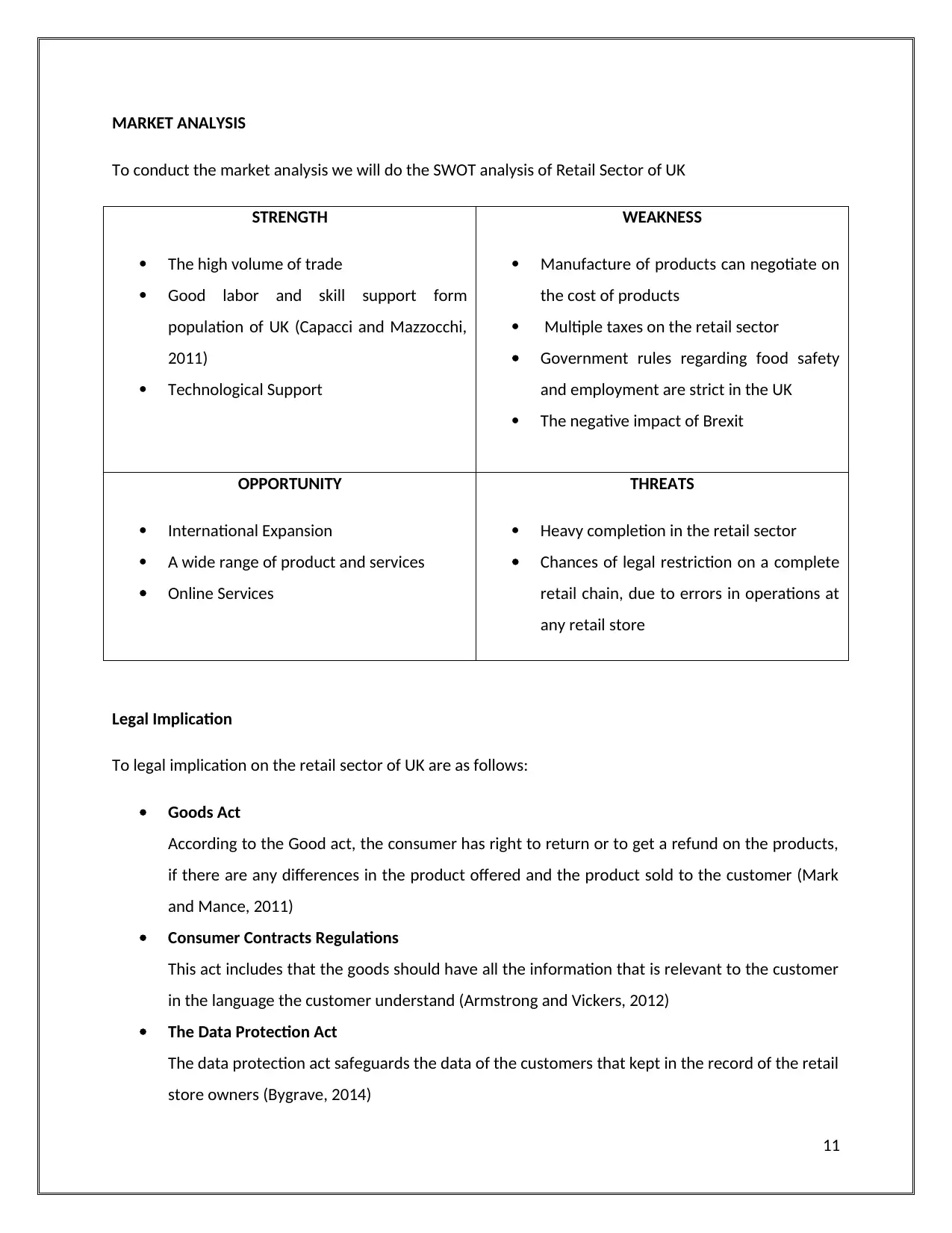
MARKET ANALYSIS
To conduct the market analysis we will do the SWOT analysis of Retail Sector of UK
STRENGTH
The high volume of trade
Good labor and skill support form
population of UK (Capacci and Mazzocchi,
2011)
Technological Support
WEAKNESS
Manufacture of products can negotiate on
the cost of products
Multiple taxes on the retail sector
Government rules regarding food safety
and employment are strict in the UK
The negative impact of Brexit
OPPORTUNITY
International Expansion
A wide range of product and services
Online Services
THREATS
Heavy completion in the retail sector
Chances of legal restriction on a complete
retail chain, due to errors in operations at
any retail store
Legal Implication
To legal implication on the retail sector of UK are as follows:
Goods Act
According to the Good act, the consumer has right to return or to get a refund on the products,
if there are any differences in the product offered and the product sold to the customer (Mark
and Mance, 2011)
Consumer Contracts Regulations
This act includes that the goods should have all the information that is relevant to the customer
in the language the customer understand (Armstrong and Vickers, 2012)
The Data Protection Act
The data protection act safeguards the data of the customers that kept in the record of the retail
store owners (Bygrave, 2014)
11
To conduct the market analysis we will do the SWOT analysis of Retail Sector of UK
STRENGTH
The high volume of trade
Good labor and skill support form
population of UK (Capacci and Mazzocchi,
2011)
Technological Support
WEAKNESS
Manufacture of products can negotiate on
the cost of products
Multiple taxes on the retail sector
Government rules regarding food safety
and employment are strict in the UK
The negative impact of Brexit
OPPORTUNITY
International Expansion
A wide range of product and services
Online Services
THREATS
Heavy completion in the retail sector
Chances of legal restriction on a complete
retail chain, due to errors in operations at
any retail store
Legal Implication
To legal implication on the retail sector of UK are as follows:
Goods Act
According to the Good act, the consumer has right to return or to get a refund on the products,
if there are any differences in the product offered and the product sold to the customer (Mark
and Mance, 2011)
Consumer Contracts Regulations
This act includes that the goods should have all the information that is relevant to the customer
in the language the customer understand (Armstrong and Vickers, 2012)
The Data Protection Act
The data protection act safeguards the data of the customers that kept in the record of the retail
store owners (Bygrave, 2014)
11
You're viewing a preview
Unlock full access by subscribing today!
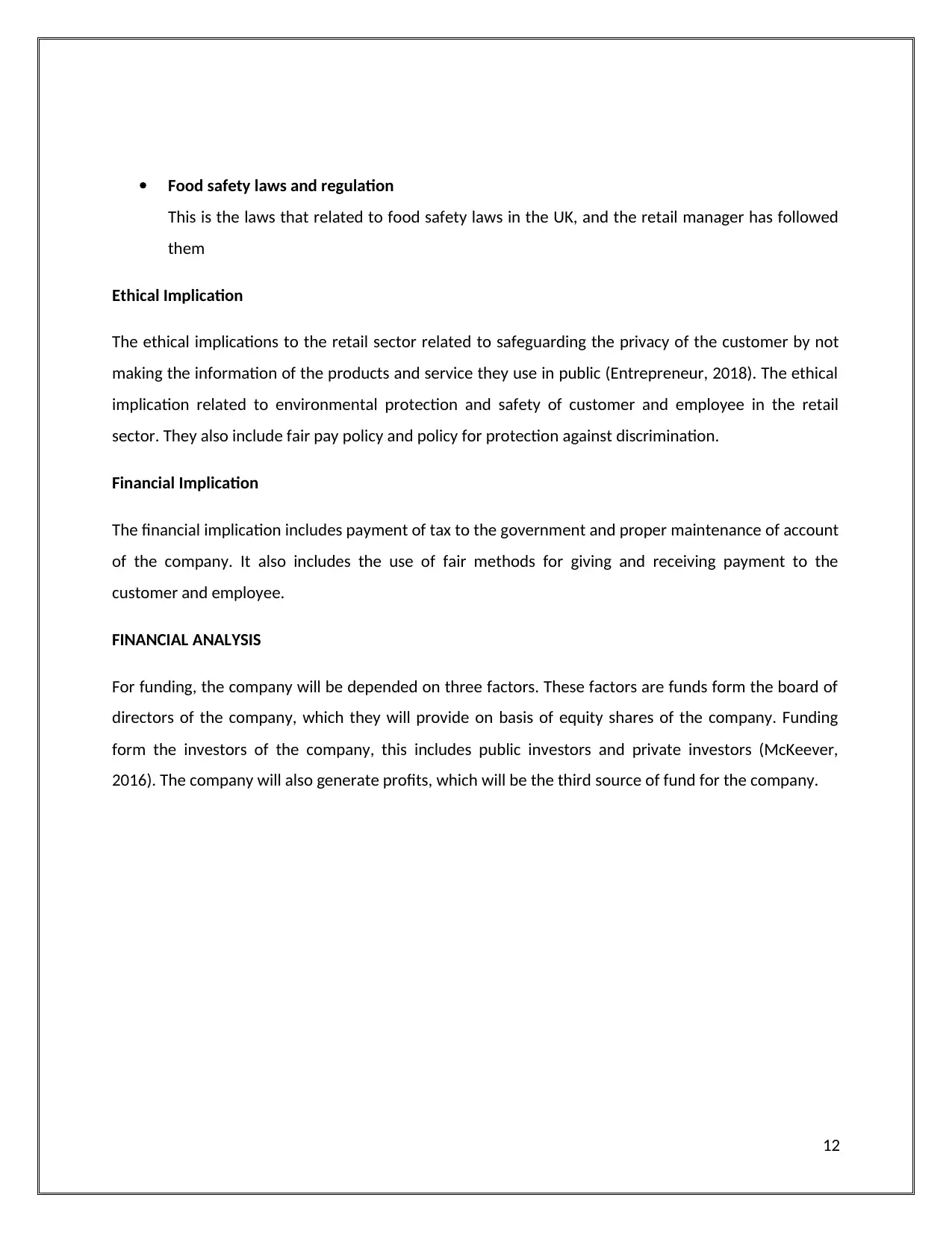
Food safety laws and regulation
This is the laws that related to food safety laws in the UK, and the retail manager has followed
them
Ethical Implication
The ethical implications to the retail sector related to safeguarding the privacy of the customer by not
making the information of the products and service they use in public (Entrepreneur, 2018). The ethical
implication related to environmental protection and safety of customer and employee in the retail
sector. They also include fair pay policy and policy for protection against discrimination.
Financial Implication
The financial implication includes payment of tax to the government and proper maintenance of account
of the company. It also includes the use of fair methods for giving and receiving payment to the
customer and employee.
FINANCIAL ANALYSIS
For funding, the company will be depended on three factors. These factors are funds form the board of
directors of the company, which they will provide on basis of equity shares of the company. Funding
form the investors of the company, this includes public investors and private investors (McKeever,
2016). The company will also generate profits, which will be the third source of fund for the company.
12
This is the laws that related to food safety laws in the UK, and the retail manager has followed
them
Ethical Implication
The ethical implications to the retail sector related to safeguarding the privacy of the customer by not
making the information of the products and service they use in public (Entrepreneur, 2018). The ethical
implication related to environmental protection and safety of customer and employee in the retail
sector. They also include fair pay policy and policy for protection against discrimination.
Financial Implication
The financial implication includes payment of tax to the government and proper maintenance of account
of the company. It also includes the use of fair methods for giving and receiving payment to the
customer and employee.
FINANCIAL ANALYSIS
For funding, the company will be depended on three factors. These factors are funds form the board of
directors of the company, which they will provide on basis of equity shares of the company. Funding
form the investors of the company, this includes public investors and private investors (McKeever,
2016). The company will also generate profits, which will be the third source of fund for the company.
12
Paraphrase This Document
Need a fresh take? Get an instant paraphrase of this document with our AI Paraphraser
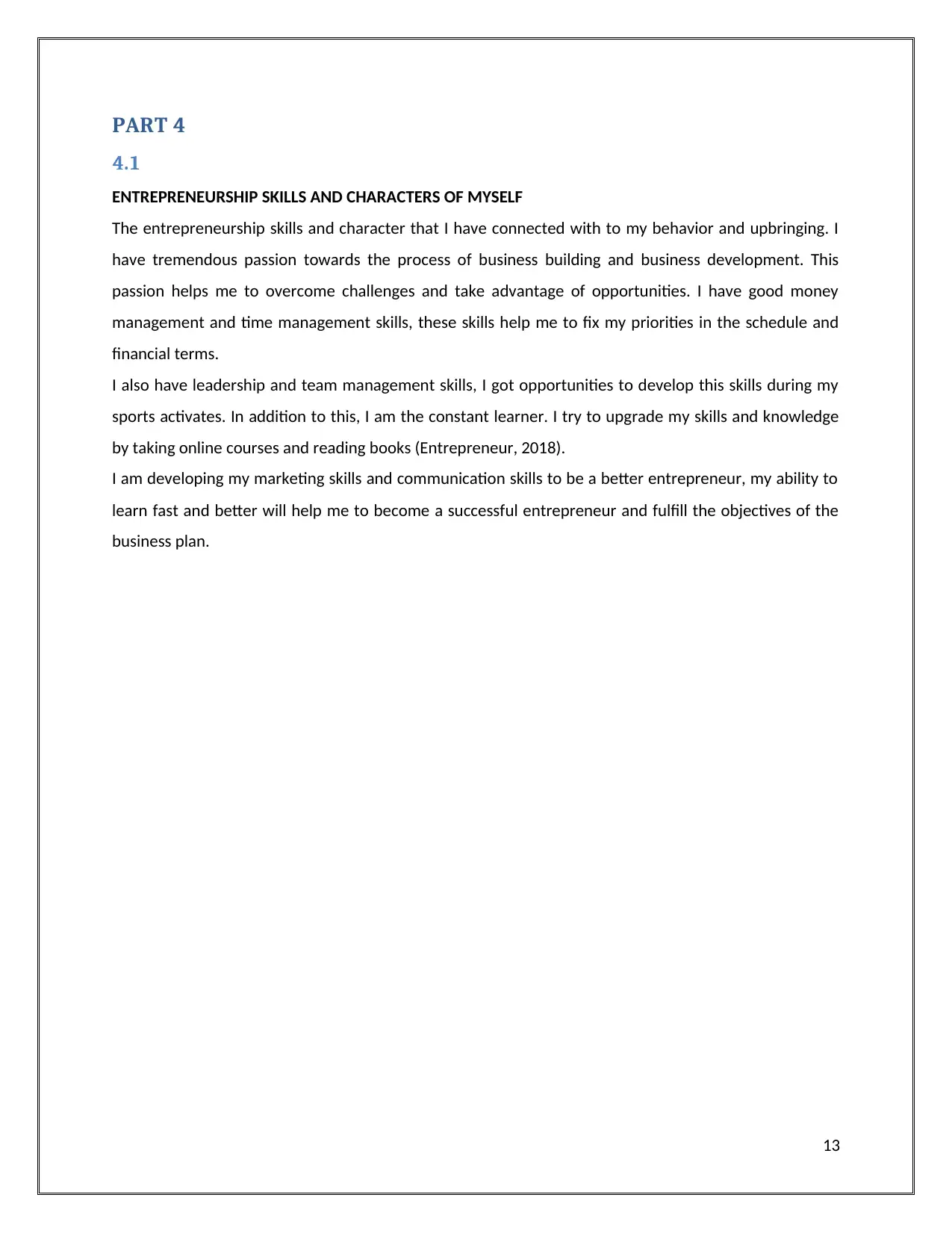
PART 4
4.1
ENTREPRENEURSHIP SKILLS AND CHARACTERS OF MYSELF
The entrepreneurship skills and character that I have connected with to my behavior and upbringing. I
have tremendous passion towards the process of business building and business development. This
passion helps me to overcome challenges and take advantage of opportunities. I have good money
management and time management skills, these skills help me to fix my priorities in the schedule and
financial terms.
I also have leadership and team management skills, I got opportunities to develop this skills during my
sports activates. In addition to this, I am the constant learner. I try to upgrade my skills and knowledge
by taking online courses and reading books (Entrepreneur, 2018).
I am developing my marketing skills and communication skills to be a better entrepreneur, my ability to
learn fast and better will help me to become a successful entrepreneur and fulfill the objectives of the
business plan.
13
4.1
ENTREPRENEURSHIP SKILLS AND CHARACTERS OF MYSELF
The entrepreneurship skills and character that I have connected with to my behavior and upbringing. I
have tremendous passion towards the process of business building and business development. This
passion helps me to overcome challenges and take advantage of opportunities. I have good money
management and time management skills, these skills help me to fix my priorities in the schedule and
financial terms.
I also have leadership and team management skills, I got opportunities to develop this skills during my
sports activates. In addition to this, I am the constant learner. I try to upgrade my skills and knowledge
by taking online courses and reading books (Entrepreneur, 2018).
I am developing my marketing skills and communication skills to be a better entrepreneur, my ability to
learn fast and better will help me to become a successful entrepreneur and fulfill the objectives of the
business plan.
13
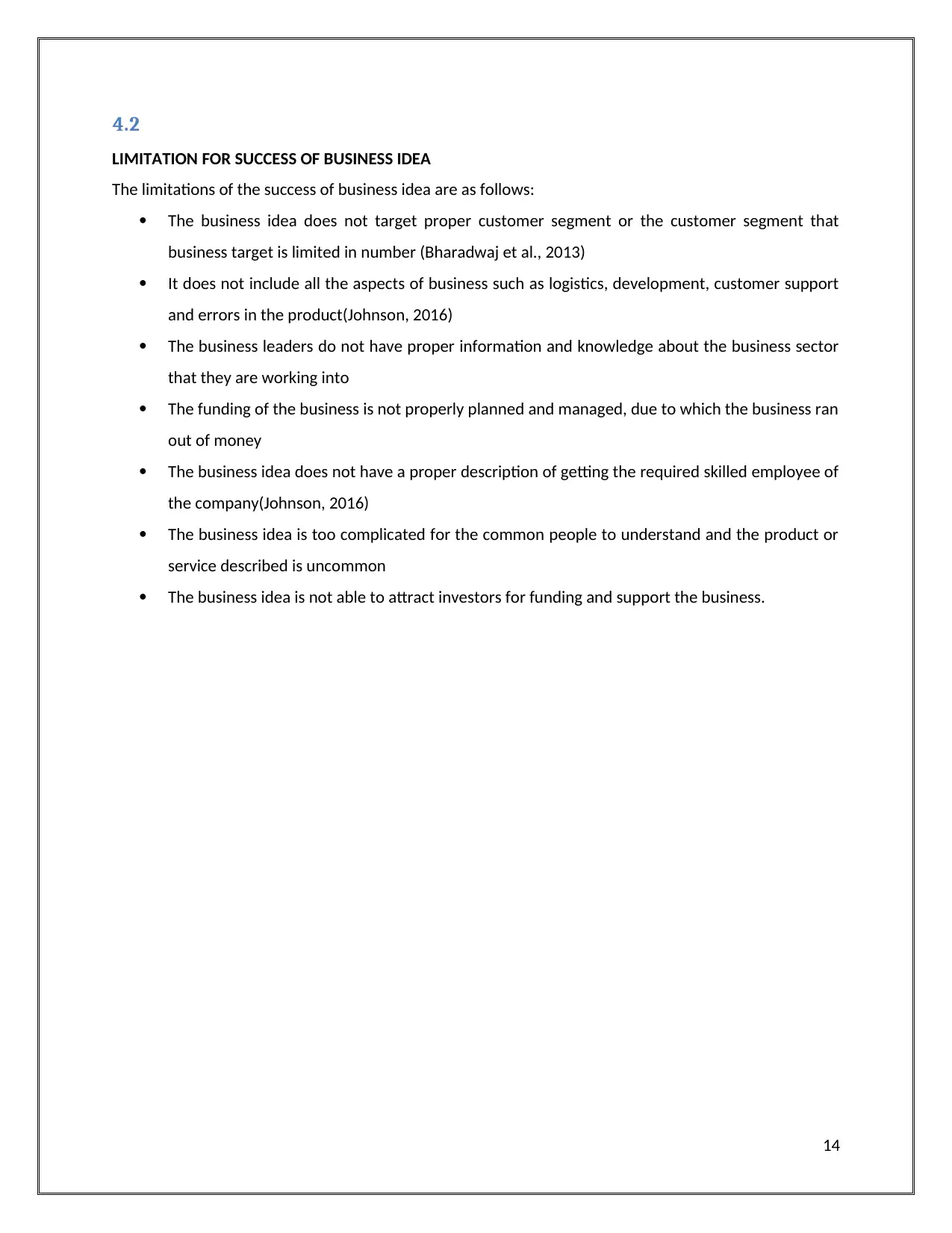
4.2
LIMITATION FOR SUCCESS OF BUSINESS IDEA
The limitations of the success of business idea are as follows:
The business idea does not target proper customer segment or the customer segment that
business target is limited in number (Bharadwaj et al., 2013)
It does not include all the aspects of business such as logistics, development, customer support
and errors in the product(Johnson, 2016)
The business leaders do not have proper information and knowledge about the business sector
that they are working into
The funding of the business is not properly planned and managed, due to which the business ran
out of money
The business idea does not have a proper description of getting the required skilled employee of
the company(Johnson, 2016)
The business idea is too complicated for the common people to understand and the product or
service described is uncommon
The business idea is not able to attract investors for funding and support the business.
14
LIMITATION FOR SUCCESS OF BUSINESS IDEA
The limitations of the success of business idea are as follows:
The business idea does not target proper customer segment or the customer segment that
business target is limited in number (Bharadwaj et al., 2013)
It does not include all the aspects of business such as logistics, development, customer support
and errors in the product(Johnson, 2016)
The business leaders do not have proper information and knowledge about the business sector
that they are working into
The funding of the business is not properly planned and managed, due to which the business ran
out of money
The business idea does not have a proper description of getting the required skilled employee of
the company(Johnson, 2016)
The business idea is too complicated for the common people to understand and the product or
service described is uncommon
The business idea is not able to attract investors for funding and support the business.
14
You're viewing a preview
Unlock full access by subscribing today!
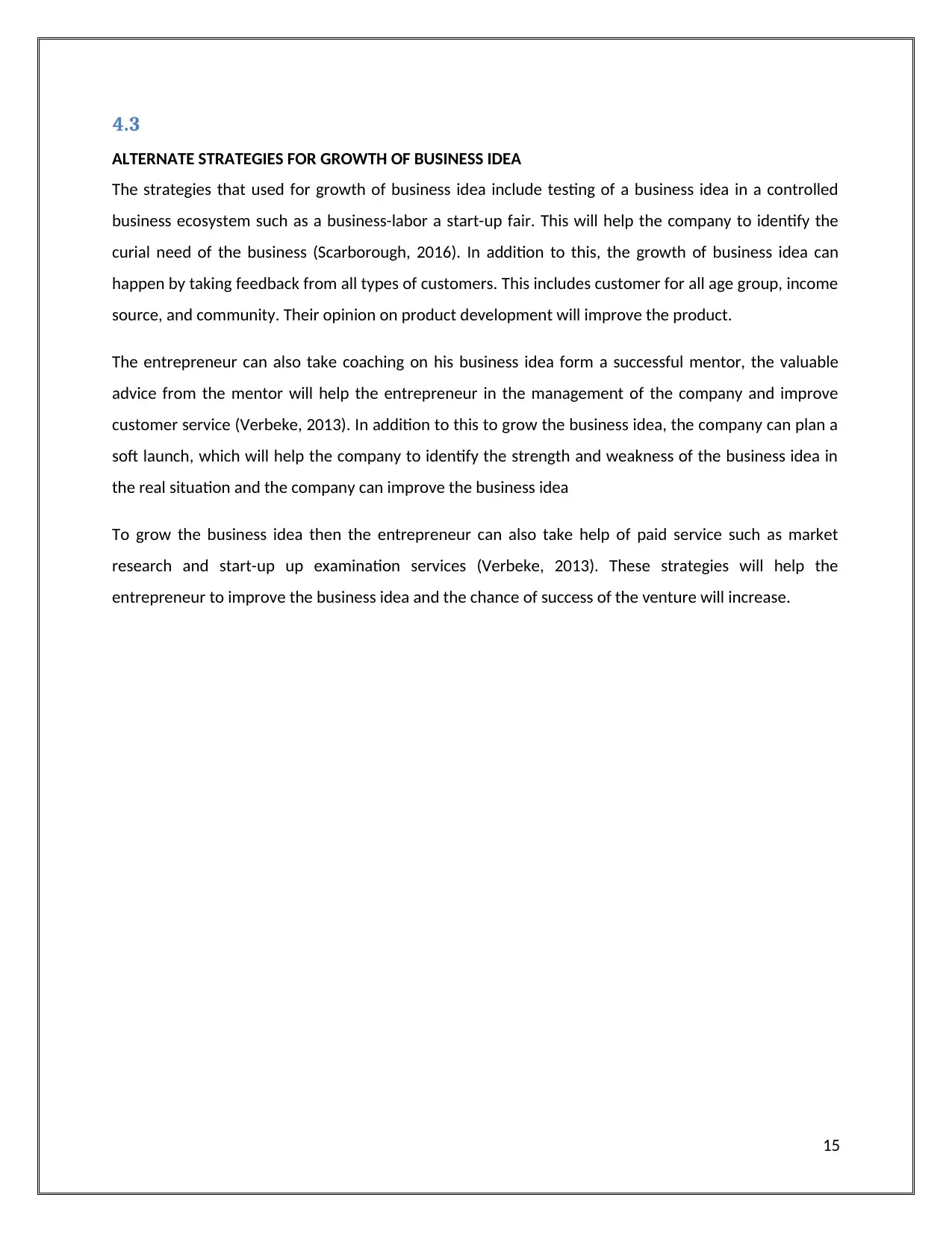
4.3
ALTERNATE STRATEGIES FOR GROWTH OF BUSINESS IDEA
The strategies that used for growth of business idea include testing of a business idea in a controlled
business ecosystem such as a business-labor a start-up fair. This will help the company to identify the
curial need of the business (Scarborough, 2016). In addition to this, the growth of business idea can
happen by taking feedback from all types of customers. This includes customer for all age group, income
source, and community. Their opinion on product development will improve the product.
The entrepreneur can also take coaching on his business idea form a successful mentor, the valuable
advice from the mentor will help the entrepreneur in the management of the company and improve
customer service (Verbeke, 2013). In addition to this to grow the business idea, the company can plan a
soft launch, which will help the company to identify the strength and weakness of the business idea in
the real situation and the company can improve the business idea
To grow the business idea then the entrepreneur can also take help of paid service such as market
research and start-up up examination services (Verbeke, 2013). These strategies will help the
entrepreneur to improve the business idea and the chance of success of the venture will increase.
15
ALTERNATE STRATEGIES FOR GROWTH OF BUSINESS IDEA
The strategies that used for growth of business idea include testing of a business idea in a controlled
business ecosystem such as a business-labor a start-up fair. This will help the company to identify the
curial need of the business (Scarborough, 2016). In addition to this, the growth of business idea can
happen by taking feedback from all types of customers. This includes customer for all age group, income
source, and community. Their opinion on product development will improve the product.
The entrepreneur can also take coaching on his business idea form a successful mentor, the valuable
advice from the mentor will help the entrepreneur in the management of the company and improve
customer service (Verbeke, 2013). In addition to this to grow the business idea, the company can plan a
soft launch, which will help the company to identify the strength and weakness of the business idea in
the real situation and the company can improve the business idea
To grow the business idea then the entrepreneur can also take help of paid service such as market
research and start-up up examination services (Verbeke, 2013). These strategies will help the
entrepreneur to improve the business idea and the chance of success of the venture will increase.
15
Paraphrase This Document
Need a fresh take? Get an instant paraphrase of this document with our AI Paraphraser
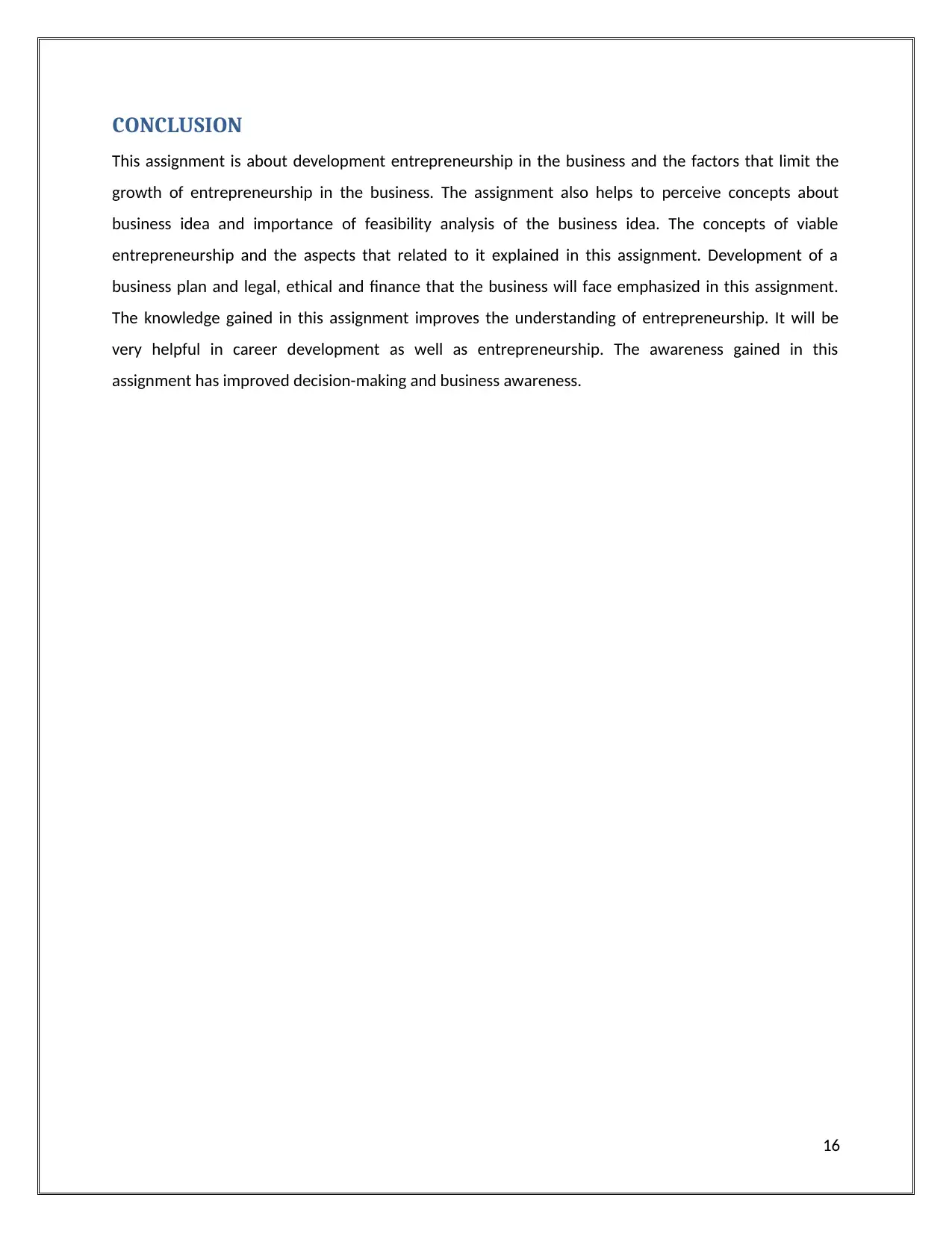
CONCLUSION
This assignment is about development entrepreneurship in the business and the factors that limit the
growth of entrepreneurship in the business. The assignment also helps to perceive concepts about
business idea and importance of feasibility analysis of the business idea. The concepts of viable
entrepreneurship and the aspects that related to it explained in this assignment. Development of a
business plan and legal, ethical and finance that the business will face emphasized in this assignment.
The knowledge gained in this assignment improves the understanding of entrepreneurship. It will be
very helpful in career development as well as entrepreneurship. The awareness gained in this
assignment has improved decision-making and business awareness.
16
This assignment is about development entrepreneurship in the business and the factors that limit the
growth of entrepreneurship in the business. The assignment also helps to perceive concepts about
business idea and importance of feasibility analysis of the business idea. The concepts of viable
entrepreneurship and the aspects that related to it explained in this assignment. Development of a
business plan and legal, ethical and finance that the business will face emphasized in this assignment.
The knowledge gained in this assignment improves the understanding of entrepreneurship. It will be
very helpful in career development as well as entrepreneurship. The awareness gained in this
assignment has improved decision-making and business awareness.
16
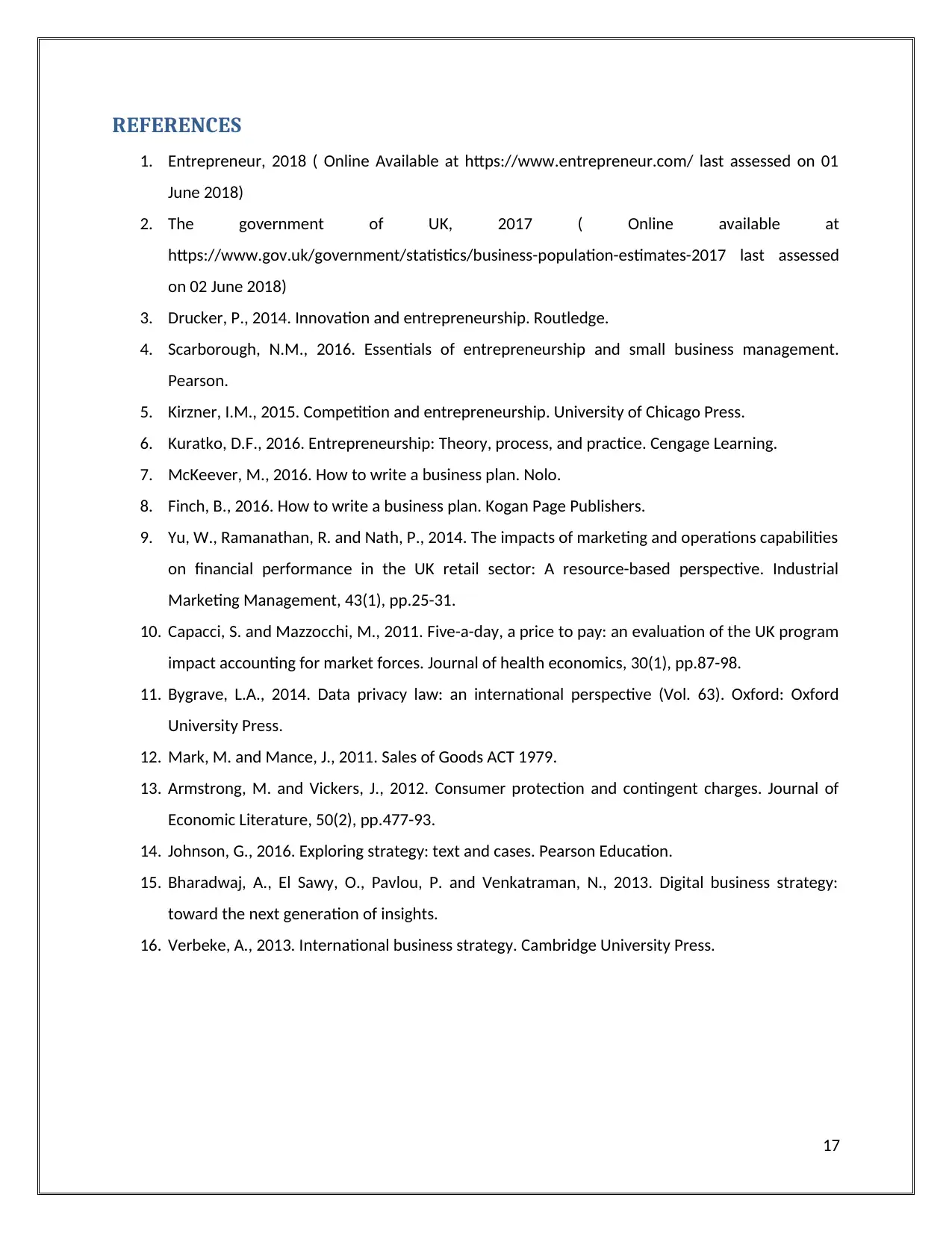
REFERENCES
1. Entrepreneur, 2018 ( Online Available at https://www.entrepreneur.com/ last assessed on 01
June 2018)
2. The government of UK, 2017 ( Online available at
https://www.gov.uk/government/statistics/business-population-estimates-2017 last assessed
on 02 June 2018)
3. Drucker, P., 2014. Innovation and entrepreneurship. Routledge.
4. Scarborough, N.M., 2016. Essentials of entrepreneurship and small business management.
Pearson.
5. Kirzner, I.M., 2015. Competition and entrepreneurship. University of Chicago Press.
6. Kuratko, D.F., 2016. Entrepreneurship: Theory, process, and practice. Cengage Learning.
7. McKeever, M., 2016. How to write a business plan. Nolo.
8. Finch, B., 2016. How to write a business plan. Kogan Page Publishers.
9. Yu, W., Ramanathan, R. and Nath, P., 2014. The impacts of marketing and operations capabilities
on financial performance in the UK retail sector: A resource-based perspective. Industrial
Marketing Management, 43(1), pp.25-31.
10. Capacci, S. and Mazzocchi, M., 2011. Five-a-day, a price to pay: an evaluation of the UK program
impact accounting for market forces. Journal of health economics, 30(1), pp.87-98.
11. Bygrave, L.A., 2014. Data privacy law: an international perspective (Vol. 63). Oxford: Oxford
University Press.
12. Mark, M. and Mance, J., 2011. Sales of Goods ACT 1979.
13. Armstrong, M. and Vickers, J., 2012. Consumer protection and contingent charges. Journal of
Economic Literature, 50(2), pp.477-93.
14. Johnson, G., 2016. Exploring strategy: text and cases. Pearson Education.
15. Bharadwaj, A., El Sawy, O., Pavlou, P. and Venkatraman, N., 2013. Digital business strategy:
toward the next generation of insights.
16. Verbeke, A., 2013. International business strategy. Cambridge University Press.
17
1. Entrepreneur, 2018 ( Online Available at https://www.entrepreneur.com/ last assessed on 01
June 2018)
2. The government of UK, 2017 ( Online available at
https://www.gov.uk/government/statistics/business-population-estimates-2017 last assessed
on 02 June 2018)
3. Drucker, P., 2014. Innovation and entrepreneurship. Routledge.
4. Scarborough, N.M., 2016. Essentials of entrepreneurship and small business management.
Pearson.
5. Kirzner, I.M., 2015. Competition and entrepreneurship. University of Chicago Press.
6. Kuratko, D.F., 2016. Entrepreneurship: Theory, process, and practice. Cengage Learning.
7. McKeever, M., 2016. How to write a business plan. Nolo.
8. Finch, B., 2016. How to write a business plan. Kogan Page Publishers.
9. Yu, W., Ramanathan, R. and Nath, P., 2014. The impacts of marketing and operations capabilities
on financial performance in the UK retail sector: A resource-based perspective. Industrial
Marketing Management, 43(1), pp.25-31.
10. Capacci, S. and Mazzocchi, M., 2011. Five-a-day, a price to pay: an evaluation of the UK program
impact accounting for market forces. Journal of health economics, 30(1), pp.87-98.
11. Bygrave, L.A., 2014. Data privacy law: an international perspective (Vol. 63). Oxford: Oxford
University Press.
12. Mark, M. and Mance, J., 2011. Sales of Goods ACT 1979.
13. Armstrong, M. and Vickers, J., 2012. Consumer protection and contingent charges. Journal of
Economic Literature, 50(2), pp.477-93.
14. Johnson, G., 2016. Exploring strategy: text and cases. Pearson Education.
15. Bharadwaj, A., El Sawy, O., Pavlou, P. and Venkatraman, N., 2013. Digital business strategy:
toward the next generation of insights.
16. Verbeke, A., 2013. International business strategy. Cambridge University Press.
17
You're viewing a preview
Unlock full access by subscribing today!
1 out of 18
Related Documents
Your All-in-One AI-Powered Toolkit for Academic Success.
+13062052269
info@desklib.com
Available 24*7 on WhatsApp / Email
![[object Object]](/_next/static/media/star-bottom.7253800d.svg)
Unlock your academic potential
© 2024 | Zucol Services PVT LTD | All rights reserved.





